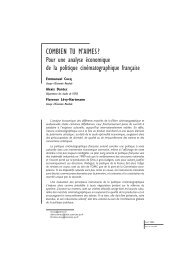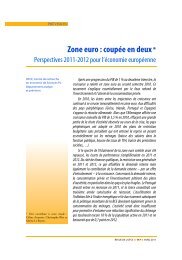direct multi-step estimation and forecasting - OFCE - Sciences Po
direct multi-step estimation and forecasting - OFCE - Sciences Po
direct multi-step estimation and forecasting - OFCE - Sciences Po
You also want an ePaper? Increase the reach of your titles
YUMPU automatically turns print PDFs into web optimized ePapers that Google loves.
Direct <strong>multi</strong>-<strong>step</strong> <strong>estimation</strong> <strong>and</strong> <strong>forecasting</strong><br />
the <strong>multi</strong>-<strong>step</strong> point forecasts are more accurate than those obtained by the other models. The<br />
prediction interval does not necessarily increase with the horizon for the “adaptive” forecast <strong>and</strong> it<br />
has the same amplitude as that of the AR(2) but, contrary to the latter, always (except at 12 <strong>step</strong>s<br />
ahead) contains the true outcome. The ARIMA model does contain the realised value too, but the<br />
forecast interval is much larger than that of the previous two models. The author concludes that<br />
<strong>multi</strong>-<strong>step</strong> <strong>estimation</strong> does indeed yield a positive outcome.<br />
In their article, Lin <strong>and</strong> Tsay (1996) study whether using cointegrating properties improve<br />
long-term <strong>forecasting</strong>. In an empirical analysis, they compare several <strong>forecasting</strong> techniques to<br />
an ‘adaptive’ procedure of <strong>multi</strong>-<strong>step</strong> forecasts, which they use as a benchmark since it does not<br />
postulate the existence of a true model. They use a non-stationary VAR(p) model for the vector<br />
of n variables:<br />
x t = τ +<br />
p∑<br />
Υ i x t−i + ɛ t ,<br />
i=1<br />
where the ɛ t ∼ IN (0, Σ). It is assumed that, letting Υ (L) = ∑ p<br />
i=1 Υ iL i , the series {Ψ i } 0 ∞<br />
is such<br />
that [Υ (L)] −1 = ∑ ∞<br />
i=0 Ψ iL i . The h–<strong>step</strong> ahead forecast error is then given by<br />
h−1<br />
∑<br />
e T +h,h = Ψ i ɛ T +h−i .<br />
i=0<br />
The DMS <strong>multi</strong>-<strong>step</strong> parameter estimates are given by minimizing the in-sample sum of the squared<br />
e t,h . This implies a non-linear function of the elements of {Υ i } 1 p<br />
. For simplicity, Lin <strong>and</strong> Tsay suggest<br />
to simply use the least squares projection of x t onto the space spanned by (x t−h , ..., x t−h−p+1 )<br />
<strong>and</strong> a constant, for t = h+p, ..., T . The computing time of this alternative estimator is much lower.<br />
Lin <strong>and</strong> Tsay compare their DMS forecasts to those obtained by cointegrated VARs for seven<br />
financial <strong>and</strong> macro-economic data sets. The vector processes are of dimension varying from 3 to<br />
5 <strong>and</strong> are estimated over samples of 230 to 440 observations. The criterion used for analysis is<br />
the square root of the average trace of the MSFE. Their results show that <strong>multi</strong>-<strong>step</strong> techniques<br />
provide a greater forecast accuracy (up to a 60% gain), but for long horizon (beyond 50) only two<br />
of the series still exhibit a gain from using DMS. The authors find it difficult to account for these<br />
results.<br />
28








